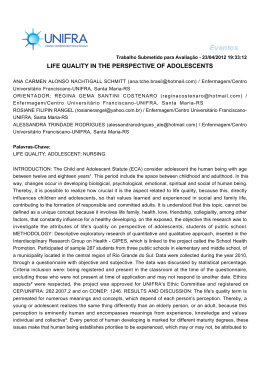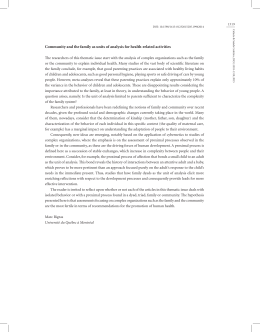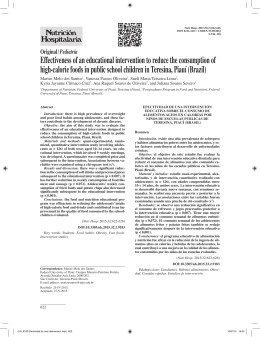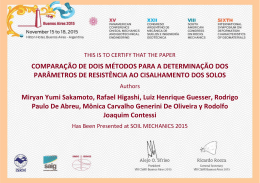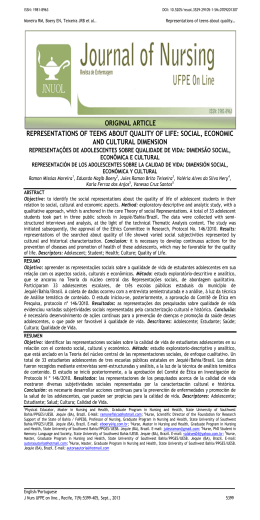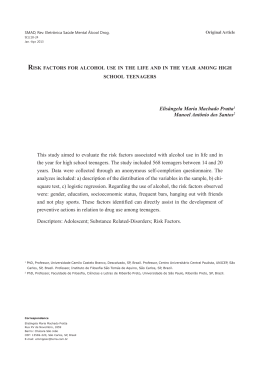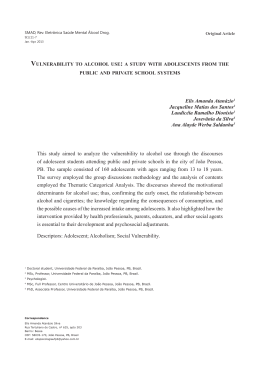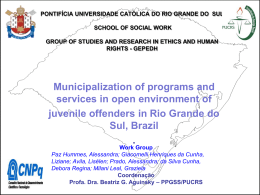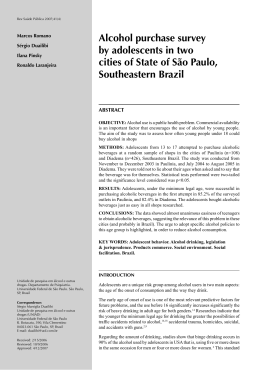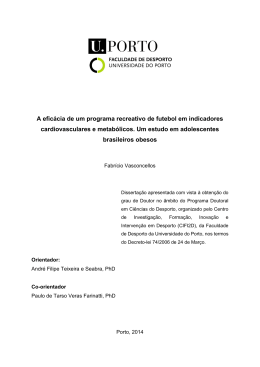Ana Gomes da Silva Alexandre Bell, nº21, 3º direito, 2870-455 Montijo [email protected] New age, new diseases, new concepts: the challenge of adolescents in pediatrics. Novas idades, novas patologias, novos conceitos: o desafio dos adolescentes na pediatria. Autores: Ana Silva1, Inês Marques1, S Neves2 1 Interna do Complementar de Pediatria do Centro Hospitalar Barreiro-Montijo – E.P.E. 2 Assistente Hospitalar de Pediatria do Centro Hospitalar Barreiro-Montijo – E.P.E. Keyword: Adolescence; Extension; Pediatric Age. Abstract: The purpose of adolescence is to acquire autonomy and identity. Teenagers, neither children nor adults, were in a limbo for the provision of health care. The lack of individuality deters teenagers, missing the opportunity for promoting health and preventing risk behaviors. Pediatrics in Portugal has made a difference by promoting the acceptance of this specific group. Objectives: To evaluate the impact of the extension of the pediatric age by the characterization of adolescents admitted to our emergency room and inpatient service. Methodology: Observational and retrospective study. Comparative analysis of populations before and after extension of the pediatric population, between January 2009 and December 2011. Results: In the emergency room there was a 3.8% increase in total admissions and in the 10-18 age group this increase was of 39.9%. The main reasons for emergency were disease (70%), accidents (in which are included the suicide attempt) (24%) and aggression (2%), a new situation since the measurements began. With regard to adolescents admitted there was an increase of 24.7%, most of them females (58.2%) and of short duration. Note that ¼ of these admissions was due to psychological / psychiatric disturbances and voluntary intoxication. Conclusion: Extension of pediatric age led us to a new reality. Risk behaviors, accidents and social problems are now a daily reality (drug use, sexuality, liberalized / unprotected, suicide attempt, conversion symptoms / somatization, abuse and neglect). There is still a long way to go towards providing the best care, with training of health care professionals and adaptation of physical spaces to the adolescent population. Resumo: A adolescência tem como objectivos a aquisição de autonomia e de identidade. O adolescente não sendo criança nem adulto, encontrava-se no limbo da prestação de cuidados de saúde. A falta de cuidados individualizados afasta os adolescentes, perdendo-se a oportunidade para a promoção da saúde e prevenção de comportamentos de risco. A Pediatria em Portugal tem marcado a diferença ao promover o acolhimento deste grupo específico. Objetivos: Avaliar o impacto do alargamento da idade pediátrica pela caracterização dos adolescentes admitidos no nosso serviço de urgência e internamento. Metodologia: Estudo observacional e retrospetivo. Análise comparativa das populações pré e pós alargamento da idade pediátrica, entre Janeiro de 2009 e Dezembro de 2011. Resultados: No serviço de urgência verificou-se um aumento de 3,8% no total de inscritos, sendo que na faixa etária dos 10-18 anos este acréscimo foi de 39,9%. Os principais motivos de urgência foram doença (70%), acidentes (nos quais estão incluídos os parasuicídios) (24%) e agressão (2%), uma situação nova desde o início da medida. Em relação aos adolescentes internados verificou-se um aumento de 24,7%, na sua maioria do sexo feminino (58,2%) e de curta duração (tempo médio 48h). De salientar que ¼ destes se deveu a perturbações psicológicas/psiquiátricas e intoxicações voluntárias. Conclusão: O alargamento da idade pediátrica conduziu-nos a uma nova realidade. Comportamentos de risco, acidentes e problemas sociais são agora uma realidade quotidiana (consumos, sexualidade liberalizada/desprotegida, parasuicídios, sintomas conversivos/somatização, abuso e negligência). Há ainda necessidade de melhorar a prestação dos cuidados, com preparação dos profissionais de saúde e adequação dos espaços físicos à população adolescente. 1 Ana Gomes da Silva Alexandre Bell, nº21, 3º direito, 2870-455 Montijo [email protected] Introduction: According to the World Health Organization (WHO), adolescence is the age between 10 and 19 years. It is a turning point in biological (puberty to adulthood), cognitive (acquisition of abstract thinking) and social (acquiring responsibility) dimensions. This is a milestone in the acquisition of autonomy and identity. This is a heterogeneous group; the transition from childhood to adulthood is not continuous, uniform or synchronous in biological, social, emotional and intellectual aspects. And it is within these differences that conflicts, difficulties and problems arise. Adolescents are a group that rarely seeks health care, except in an emergency situation1. On the one hand, they are a healthy group, unwilling to accept that they need help to overcome their problems. On the other hand, the lack of individualized care, the restructuring of services (more suitable for children and adults), unawareness as to the possibility of receiving support in health and lack of adolescent-friendly structures make us miss the opportunity to promote health and prevent risky behaviors. Gradually, Pediatrics in Portugal has been able to draw attention to this particular group, and has recently implemented measures of the utmost importance. New health policies were put in place for young people aimed at: promoting health in its various dimensions (physical, mental and social wellbeing); promoting healthy lifestyles (sexual and reproductive health, physical activity, nutrition, prevention of drug use); stimulating the development of a "culture" of safety, preventing the various forms of abuse and exploitation; ensuring the adequacy and continuity of health services' responses, especially to those with special health needs, contributing to the preservation of the physical and social environments that allow a balanced development in this population2. In this context, on the 1st of June, 2010 our hospital, following in the footsteps other hospitals across the country, extended the pediatric care up to 18 year-olds, adapting the physical spaces in the emergency room, consultation and internment. Respecting the privacy of the adolescents, they can come to us without parental permission or supervision. Just as important as the physical space changes, there were changes in the attitude of professionals and relationship with teenagers and the training of the health care professionals and teams in adolescent medicine. In providing health care to adolescents, certain conditions are the foundation of a good doctor-patient relationship and those will lead to the successful reception of this age: the importance of privacy and confidentiality, respect for the adolescent’s identity, autonomy and sexuality3. The team should be multidisciplinary (pediatrics, child psychiatry, nursing, psychology, gynecology, obstetrics, nutritionist), and work in inpatient and outpatient settings. Not forgetting however the specific needs of adolescents’ inpatient, such as privacy, written information tailored to suit their needs, a suitable play/lounge space and teachers/school support. Thus our objectives are: to provide effective, safe and appropriate hospital care for children, adolescents and their families, by qualified professionals in a friendly space for children and adolescents; always focusing on outpatient care. 2 Ana Gomes da Silva Alexandre Bell, nº21, 3º direito, 2870-455 Montijo [email protected] 2. Methods: 2.1 Study design: Retrospective observational study conducted between January 1st 2009 and December 31th 2011. The information was collected based on the medical records of inpatients and emergency room adolescents observed in these sectors. 2.2 Parameters analyzed: total number of admitted patients (0-18 years), total number of adolescents admitted (1018 age group and 15-18 subgroup), sex and age group, reasons of emergency and internment in the subgroup 15-18. 2.3 Statistical analysis: Statistical analysis was performed using the Statistical Package for Social Sciences (SPSS) version 20.0, for a confidence interval of 95%. 3. Results and Discussion Comparing the emergency room (ER) observations before and after the extension of pediatric age, we observed that in the 2009/2010 period (pre extension of pediatric age) a total of 58,315 patients were seen, corresponding to 16.2% (n = 9448) to the group of adolescents (10-18 years old). In the 2010/2011 period, (after extension of the pediatric) 60,535 patients were observed, representing the group of adolescents to 21.8% (n = 13 215). This amounts to a 3.8% increase in the total of adolescents observed in ER. In the age group of 10-18 years this increase was even more significant: 39.9%. ER Observations 2009/2010 2010/2011 Fig.1: Comparative analysis of ER observations in adolescents, before and after the extension of pediatric age. 3 Ana Gomes da Silva Alexandre Bell, nº21, 3º direito, 2870-455 Montijo [email protected] The main reasons for observation in the ER were disease, especially respiratory and digestive system, (70%), accidents, in which are included the suicide attempts (24%) and aggression (2%), a new situation since the measurement began. Situations related to teen pregnancy were also observed for the first time in our ER. Adolescents Observations in the ER Fig.2: Comparative analysis of the reasons for observation in the ER in adolescents, before and after the extension of pediatric age. Total Admissions With regard to admission, in spite of a decline of approximately 13% (n = 156) in the total of hospitalized patients there was an increase of 24.7% in relation to the number of adolescents. Age distribution in internment 2009/2010 Inpatients between 10-18 years old Age distribution in internment 2010/2011 4 Ana Gomes da Silva Alexandre Bell, nº21, 3º direito, 2870-455 Montijo [email protected] Most teenagers who required hospitalization were female. The hospitalizations were of short duration (average time of 48 hours). Sex distribution in internment between 10-18 years old in 2009/2010 Sex distribution in internment between 10-18 years old in 2010/2011 Regarding the reason for hospitalization, we noted that ¼ of these were due to psychological/psychiatric disorders and voluntary intoxication, alerting us to the new reality that is the extension of the pediatric age. Reason for Hospitalization in the group age between 15-18 years old (%) (falta substituir estes títulos dos gráficos – não consegui) 5 Ana Gomes da Silva Alexandre Bell, nº21, 3º direito, 2870-455 Montijo [email protected] 4. Conclusion The extension of pediatric age conditioned not only a greater to the ER but also a higher occupancy rate in admissions. New problems, such as risk behaviors, accidents and social problems are now present in our everyday reality (drug use, sexuality liberalized /unprotected, abuse, neglect). There are still improvements to be implemented, such as the specific skills of health professionals in adolescent medicine, multidisciplinary work with ongoing support of psychology and child psychiatry, and adequacy of physical spaces to adolescents (waiting rooms in emergency and outpatient and lounge/study room in the hospital, accessible all day). And, given the teenagers’ reality, we must remember that hospitalization is an opportunity for prevention and health education, to show that we are welcoming and friendly. In summary, there has been a significant increase in the activity of care with regard to adolescent health, and in a short time, we managed to reach a number of important goals. However, the need to evolve towards better care for this population, as special as it is specific, still remains. 5. Bibliography: 1. “Epidemiology of health and illness”, ABC of Adolescence – BMJ. February 2005. 2. “Programa Nacional de Saúde dos Jovens”, Direcção-Geral da Saúde, Divisão de Saúde Materna, Infantil e dos Adolescentes. 2006/2010. 3. “Consent, competence and confidentiality”, ABC of Adolescence – BMJ. February 2005. 4. “Acolhimento e estadia da criança e do jovem no hospital”, Instituto de Apoio à Criança. Março 2006. 6
Download
